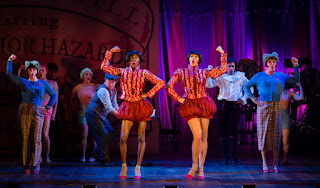This was my third exploration this year of new architecture in London. After Paddington Basin and the Victoria and Albert Museum, yesterday I visited the Royal Academy to see how the £56 Million upgrade had transformed this historic centre. I started at the old main entrance on Piccadilly.
Ignoring the galleries in Burlington House that I had visited before, I made my way to the bridge that takes you to the new restoration of 6 Burlington Gardens. First encountered is the staircase.
My photos from the bridge........
... compare nicely with that below from the Sunday Times Culture magazine of 20th May 2018 that gave me the encouragement to plan this visit.
6 Burlington Gardens is where the vast majority of the work took place. The building was acquired by the Royal Academy in 2001 and was established as the Museum of Mankind. David Chipperfield Architects won the competition at the third time of asking and ten years later their designs have come to fruition. The entrance on Burlington Gardens is now a fine renovation of the facade and historic sculptures.
Inside I needed to find a floor plan that showed the new spaces, however I had to wait until today to find one.
6 Burlington Gardens is at the top. On the right is the new lecture theatre, on the left the Pace Gallery (more later). Immediately above the bridge are two new temporary galleries, including the one for the Renzo Piano exhibition (also see later). These have extended the overall gallery space for the Royal Academy by a staggering 70%. These are contemporary spaces, full of light and modern materials. "The Gabrielle Jungels-Winkler Galleries provides the Royal Academy with an impressive third suite of galleries for temporary exhibitions. Refurbished with state of the art conditions, the galleries are naturally day-lit and will support an exhibition programme of contemporary art and architecture".
I had booked a ticket for the Renzo Piano - The Art of Making Buildings. The gallery as below:
From the Centre Georges Pompidou to The Shard, on display are drawings, photographs and models of many of his famous buildings. What amazed me most of all was how Renzo Piano embraced the science of structure into his designs. The free brochure that accompanies the exhibition says: " Piano comes from a family of builders, and has developed a complete command of the construction process, designing, as he says, "piece by piece". His work with Arup Engineers and engineer Peter Rice with whom he joined the partnership Atelier Piano and Rice in 1977.
I was impressed by his work on the joints in the structure of his designs. I learnt about the "gerberette" that connects beams, columns and external bracing at the Pompidou centre. Not only a piece of engineering magic, but beautiful in their own right.
The complexities of The Shard's design are well documented. I liked the bound A3 size presentation packs and especially the early sketches complete with illegible notes.
The models and creativity of the Cultural Centre in New Caledonia are amazing.
The Whitney Museum of American Art is amongst the 16 buildings, each on it's own white square table.
Leaving this gallery, I found the Pace Gallery noted above. I was more interested in the gallery itself rather than the Brent Wadden exhibits.
It was lunchtime when I left the Royal Academy. I didn't have too long before I was due at the theatre and the queues at Pret a Manger and Costa Coffee on Piccadilly were too long. However there was no queue at Cafe Nero on Haymarket where a coffee and a toastie were perfect.
For the afternoon I had booked for the matinee for Pinter Four at the Harold Pinter Theatre - see separate post.





































